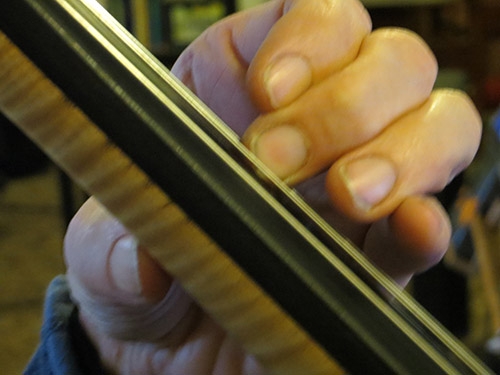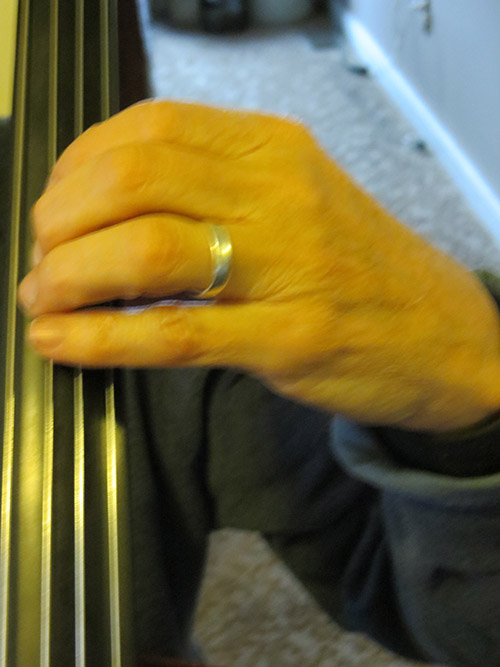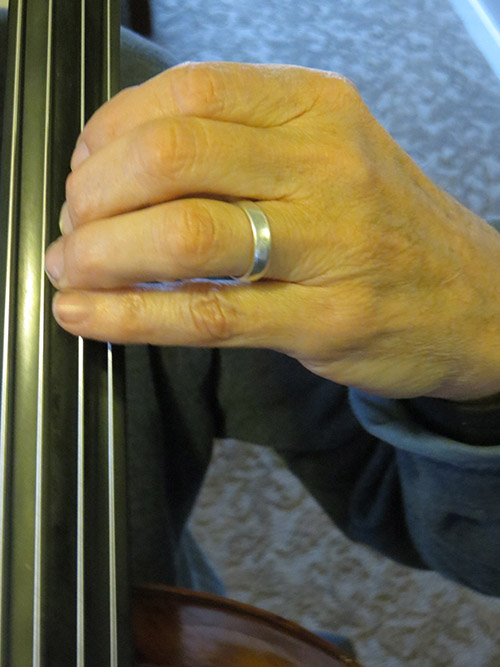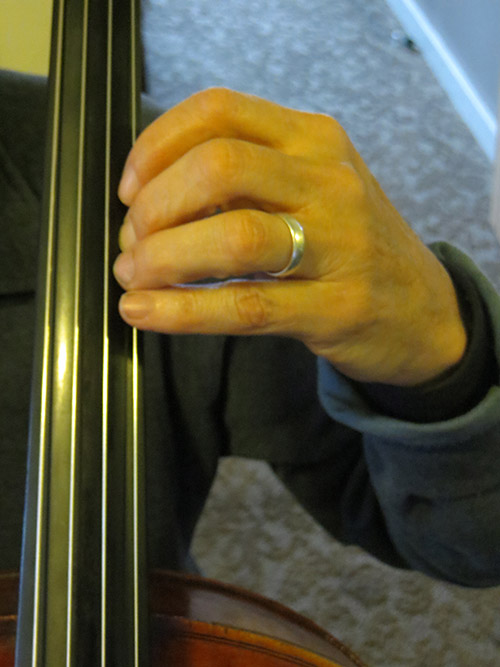The Cellist
Issue #3
A CD-Quality Vibrato
The technique that many cellists seem to desire most as they advance is vibrato. And while it is true that when most music lovers think of the sound of a cello, it includes that vibrato, a great vibrato involves much more than just being able to produce a back-and-forth motion of your left hand with a fingered note.
Let's begin by describing two types of vibrato motion: 1. with the thumb stationary on the neck, and 2. with the thumb moving with the hand. Because every anatomy is different, most cellists find one of these methods preferable to the other, although many do both depending on the note(s) involved or effect desired. And before we even begin that, I want to caution beginning cellists to not attempt vibrato before they have learned to shift fluently. I'll explain why later.
Vibrato 1: Thumb stationary on the neck. Place your 2nd finger on any note that would put you in any of the first four positions: for our purposes here, we'll use G on the D-string. Now place your thumb on the neck directly under the 2nd finger. As this is purely a left hand exercise, put your right hand in your lap. Now, anchor your 2nd finger on the string and slowly roll your hand-wrist-forearm back and forth, initiating the motion from the forearm and in the process rolling the pad of your finger on the string forward and back (see photos 1 & 2).
Photo 1
Photo 2
A common error is to initiate the vibrato from the wrist, which usually involves dropping that wrist (see photo 3) and abbreviates the motion in the forearm, even though there is still motion there. A good report card for success here (although it may cause some cellists embarrassment) is if the bottom portion of the upper arm wants to flop back and forth a bit.
Photo 3
Vibrato 2: Thumb moving with the left hand. As in Vibrato 1, place your 2nd finger on any note that will put you in one of the first four positions. This time place your thumb under your second finger, but let it barely contact the polish on the back of the cello neck. Now, while anchoring your 2nd finger on the string, move your left hand in a relaxed, straight-line motion, first toward the bridge and then toward the nut (photos 4 & 5), letting your thumb slide lightly along the neck directly under the vibrating finger, the pad of which rolls up and back on the string to slightly raise and lower the pitch.
Photo 4
Photo 5
These are the rudiments to the two methods of vibrato and we'll return to them for more intricate details, but let's now discuss the goals and quality of a great vibrato.
1. A great vibrato must have a distinct "wobble" to it. You've certainly heard it on stage and in recordings, and that wobble only occurs if the vibrato is smooth, of proper speed, and most importantly centered on the note involved. Here's what actually creates that "wobble" that is the goal of all vibrato. Assuming a cello has been accurately tuned, when a note played on it is perfectly in tune, the cello will respond with a distinct ring to that note and an increasing absence of that ring as the note becomes more & more off pitch. This is how all string players who achieve precise intonation accomplish it and we'll discuss this in much greater depth when we discuss the topic on dead-center intonation. Therefore a successful vibrato originates in the center of pitch where it produces the ring. Then, as the finger rolls forward (with either of the two methods), the pitch leaves the center and the ring vanishes. The finger rolls backwards crossing the center of pitch and again a ring occurs, then as it continues backwards, the ring again subsides. The wobble is in some part a variation in pitch, but what you hear more is a "ring - no ring - ring - no ring" effect. If your vibrato is not centered on the pitch, it will sound (sorry) truly awful, not just because the intonation is wrong, but because the wobble, if it occurs at all, is off center. Now here's the good news. Despite some teachers and coaches warning you not to use vibrato because it will mask bad pitch, a good vibrato can actually help you find dead-center intonation. Think about it. If you are vibrating a note and you are slightly off pitch, it's not difficult for your ear to detect that. Things are off balance and the sound is bad. Simply by rolling your finger forward or back, you can balance the wobble and center the pitch. All within milliseconds.
2. To be effective, a vibrato must be controlled, both in speed, and in amplitude. You've no doubt witnessed cellists you know vibrating every note they play and vibrating each note exactly the same as the previous one. If you already have a satisfactory vibrato motion, select a note and practice your vibrato at different speeds. This takes some time to accomplish, so do it every day with each finger. The same thing with amplitude: the width of your vibrato. There are occasions that work best with a narrow vibrato, and those that work best with a wide one. Practice going from narrow to wide each day with each finger.
3. A corollary to #2 is that vibrato must always be a choice: thinking again of those who vibrate every note possible simply from force of habit. Many notes sound better with vibrato but the type of vibrato (wide, slow, tight, fast etc.) varies with each situation. The more you practice varying your vibrato with each note, the more it will become part of your musicality.
4. An effective vibrato is also a product of good bowing. As a teacher I notice many students who have achieved a promising vibrato motion, are getting better at centering it on pitch, but are still frustrated by the lack of good sound. As the mind can do only one difficult thing at a time, there's was focused so much on the vibrato motion that their bow was barely moving. Make sure your bow is putting out sound also.
5. Many dynamics marked in your parts can be enhanced by your vibrato. Think of sf: sometimes a quick "sting" with a tight, fast vibrato can make a sforzando much more effective. Or a gathering intensity of vibrato while making a crescendo can put an audience on the edge of its seat. Sometimes a "sigh", a note tapered suddenly, can touch heartstrings if you lighten a fast bow to nothing while increasing your vibrato and maintaining it after the bow has left the string.
6. Continuous vibrato. You've no doubt heard someone playing a cello who would vibrate certain notes (even all of them) for an instant, then stop for a bit until he/she is settled on the next note. This is an almost unavoidable step early on the way to a great vibrato, but it is certainly not how you want to perform. Great cellists all have vibratos that can go from one note to the next without stopping, at least audibly.
A great vibrato takes time and practice, so let's return to the basics. If you're just in the process of trying to acquire the vibrato motion, practice it left hand only at first. To perform a comfortable, effective motion it's very important to relaxedly collect all your other fingers around the finger vibrating the note and, whether your thumb is stationary or moving, keep it under the finger doing the vibrating (see above photos). Just as important is having the hand as directly above the note as possible.
Photo 6
Photo 6 (above) shows the hand in poor position because it is too low, photo 7 (below) shows a correct, more upright position.
Photo 7
Note the collected fingers and position of the thumb. These relaxed, collected fingers are a departure from the "block" position that all cellists learn when they begin. That "block" (photo 8) is important and necessary in the beginning in order to train the fingers to acquire the proper spacial relationships of the notes.
Photo 8
But the very act of spreading the fingers, even a tiny bit, creates tension in the hand and tension, as much as anything else, will get in the way of successful playing, especially vibrato. Some tension is unavoidable (extensions come to mind), but the more we can eliminate it the better and more easily we will play.
Now add pizzicato, and leave the bowing until later. For many at the beginning, bowing while attempting vibrato is akin to rubbing your head and patting your stomach at the same time: the mind, being able to do only one difficult thing at a time, has trouble separating the two motions as it is concentrating on the vibrato motion. Once you have achieved the ability to make a vibrato motion that you can bow with, the next step is to practice with each finger. Select a note that seems comfortable: C-string notes are good because they guide your left hand into a more upright, directly-above-the-note position. Then move successively to the G, D and A strings, keeping your hand upright and moving the thumb toward the A-string as you move your fingers there (photos 9-12).
Photos 9-12
Now select notes that will produce a nice ring if played in tune: D on the A string and G and the D string come to mind. Vibrate those notes with each finger, carefully adjusting your pitch by rolling the finger on the note in order to center the pitch until a noticeable "wobble" is achieved. Note: even if you have trouble hearing the "ring" of a note in tune, you'll have much more success with the balanced wobble as it is much more obvious to the ear.
Continuous vibrato is largely a matter of relaxation and a lot of practice. A common stumbling block in continuous vibrato is the preparation for a finger to go to the next note while still vibrating. It almost always stops the vibrato dead in its tracks because, as a finger is extended in anticipation of placing it on the next note the hand (as explained earlier), it comes under unavoidable tension which is the main enemy of vibrato. Believe it or not, your hand and finger know exactly where that next note is and no preparation is necessary. Trust your hands. You'll surprise yourself.
Vibrato comes more easily to some rather than others. But every cellist, with attention to the details explained above can, over time, develop a truly beautiful vibrato and improve intonation in the process. It takes patience and a willingness to sound bad for a while. Yes, sound bad. Vibrato is not something that sounds great to anyone on the first try, or even after a few months of practice. But if you're willing to truly work on the relaxation of your hand (the real key to vibrato) and practice daily with the proper position, I guarantee success.
In the next issue we'll discuss the Secrets of Dead-Center Intonation.












